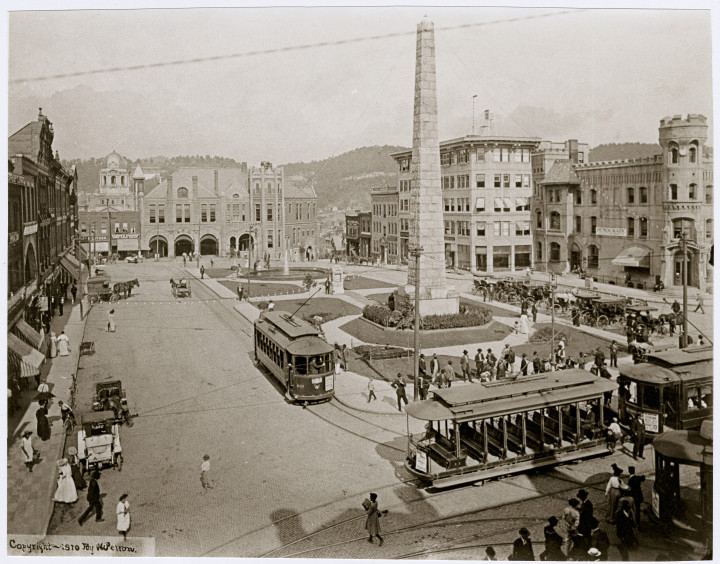Last week marked the 83rd anniversary of Asheville’s final trolley ride. On Thursday, Sept. 6, 1934, an advertisement on Page 8 of The Asheville Citizen announced the following:
“Come along with the crowd and take your last trolley ride! You probably will miss the thrill of your first ride but that will be replaced by the jolly good fellowship of your fellow passengers. There will be ample room … candy, soda pop, newspapers, and what-not … all in the hands of fellows you know. Don’t be late — the first car leaves Government and Haywood streets promptly at 4 o’clock!! When the last car returns, electric trolleys will be history in Asheville and Western North Carolina.”
After 45 years of service, the final seven streetcars departed from Pritchard Park that day, headed toward West Asheville. The 45-minute round trip, farewell tour included 500 passengers. Veteran employees and owners were among those riding the trolleys, including seven of the Carolina Power and Light company’s oldest motormen: John R. Drake, R.L. Williams, J.A. Bell, A. Whisnant, E.N. Engle, P.C. Stroupe and M.R. Winters.
The Asheville Citizen provided pre- and post-coverage of the historic event. On Wednesday, Sept. 5, the newspaper ran a statement offered by Charles S. Walters, vice president of the Carolina Power and Light. In it Walters said:
“Operation of the last streetcar in the city of Asheville is more than the mere ending of trolley service. It is a significant event for many reasons. It is significant because it means that another form of transportation has outlived its usefulness. It is significant because Asheville was the second city in the country to have electric cars. And it is significant because it means that a new means of mass transportation must be provided for our citizens.
“Only those of more mature years are able to really appreciate the part our electric trolley lines have played in the development of Asheville. They made it possible for the city to spread out and for the people to enjoy suburban life. They furnished recreation in the days when Sunday strolls and trolley rides were popular pastimes for the masses. And they gave Asheville the impetus that moved it from a struggling village to a young city.”
Buses would replace the street cars. On Sept. 16, 1934, the Sunday edition of the Asheville Citizen-Times noted that the new mode of transportation shaved off an average of 2 ½ to 5 minutes per ride, compared to the former trolleys. The price for each bus was $4,000, with operating costs that averaged about 16 cents a mile.

In the same article, the history of Asheville’s trolley system is relayed. According to the account, the first trolley test run occurred on Feb. 1, 1889. It featured three cars. Contractor, E.D. Davidson and engineer John H. Barnard are credited for the cars’ debut. The article goes on to note a publicity stunt carried out by Davidson that day: “When the foot of the South Main street (now Biltmore avenue) hill was reached, [Davidson] hitched six horses to one of the cars. The other two went up the hill on the power in triumph, while the six horses labored and struggled with theirs.”
On Sept. 7, 1934, the day after the final rides, The Asheville Citizen recapped the event. During the farewell tour, the Asheville Rotary Club hosted a fundraiser inside the seven streetcars, raising money for children with disabilities. While no fares were imposed on riders for the final trip, donations were accepted. The organization raised $144.71.
That day’s newspaper went on to report that “a quartet, led by H. Grady Reagan, chairman of the board of county commissioners, sang ‘The Last Round-Up,’ from the second story window of a building on College street … overlooking the cars.” Later on in the article, the crowd’s ambivalence was addressed: “Although the general motif was gay, there was an undercurrent of sadness among many of the passengers at the passing of the familiar streetcars which had served the city so long.”





Thomas, did you know that there was a motor court composed of decommissioned trolley cars? AA265 Fortune’s Street car Tourist Camp…..somewhere around about Arden is my best guess….is the postcard in the NC Collection. I just thought you might find that interesting. Hope you are well. Thanks for promoting Asheville history.
Terry Taylor
Friends of the NC Collection Board Member
I did not know this, Terry. Thanks for sharing. And keep up those doctored postcards (they always make me laugh when I visit the NC Room).
Oh you should see them all. I am working on an entire series of them. They won’t be shown at the show I’m having in November at a local space…..but the ones I’m exhibiting have the same spirit and you’d probably like them as well. I’ll send you an invite when the time draws nigh. Terry
Its really cool and I like trollrys